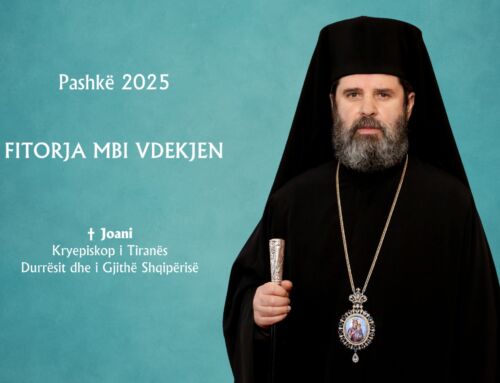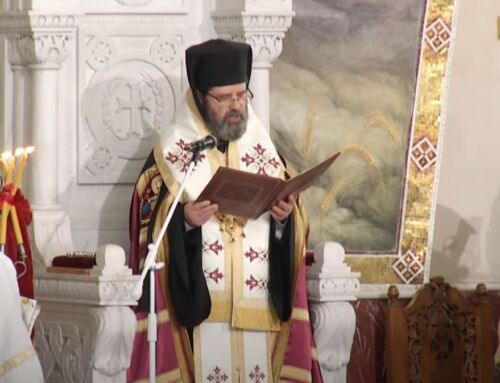Dionysius the Areopagite
The theological writings which appeared in the sixth century under the name of Dionysius the Areopagite were generally accepted by both the defenders and the dissenters of the doctrines of the fourth and fifth ecumenical councils. These writings had great influence on the liturgical piety of the Church through their symbolical explanations of the rituals of worship. They presented a mystical theology which stressed the absolute incomprehensibility of God, and His absolute “otherness” from everything else which exists in His divine creation. They did, however, contain a doctrine concerning Christ which caused grave difficulties in the seventh century.
The Dionysian writings contained the teaching that Jesus Christ, the incarnate Son of God, had one theandric will and action which completely combined the two distinct activities and operations of His divine and human natures. This doctrine was called monothelitism (which means that Christ had only one divine-human will), or monergism (which means that Christ had only one divine-human action, operation or energy). It was eagerly accepted by those who thought that this doctrinal formulation would finally solve the problem of the division of the monophysites, and reunite them to the Church.
The monophysites did, in fact, deeply appreciate the teachings of the Pseudo-Dionysian writings. The anonymous author of these works was himself most likely a monophysite. In spite of this, the expected reunion of those who were divided from the Church since the middle of the fifth century did not come. The reason why it did not come was the fierce opposition to the doctrine of the one theandric will and action in Christ by Saint Maximus the Confessor (d.662) and Pope Saint Martin of Rome (d.655).
Saint Maximus the Confessor and Saint Martin
Both these men, together with their staunch supporters, insisted that Jesus Christ must have two distinct and separate wills and actions, just as He has two distinct and separate natures in one person. The Holy Fathers insisted there is one Son of God Who is one Son of Mary, but this one Son wills and acts distinctly as God and as man.
Christ has the fullness of the divine will, energy, action, operation, and power which is the same as that of the Father and the Holy Spirit. Christ also has the fullness of the human will, energy, action, operation, and power which is the same as that of every other human being. Salvation consists in the fact that Jesus Christ, being a true human, freely and voluntarily submitted his human will (which is exactly the same human will that all men have) to His divine will (which is the will of God). Thus the divine Son of God became a real man with a real human will so that as a real man He could “fulfill all righteousness” in perfect, voluntary obedience to His Father. It is through His genuinely human action that Jesus Christ frees all men from sin and death as the New and Final Adam.
Saint Maximus and Saint Martin suffered greatly for opposing the monothelyte position. They were imprisoned, tortured, and mutilated by the imperial powers who wanted badly to use monothelytism as a way to reunion with the monophysites.
The Sixth Ecumenical Council
Ultimately, however, the doctrine of these saints prevailed. The Third Council of Constantinople, known as the Sixth Ecumenical Council, held in 680-681, officially verified their teaching and formally condemned both Patriarch Sergius of Constantinople and Pope Honorius of Rome, together with all who defended the false doctrine about Jesus that deprived Him of His genuine humanity.
Theological Writings
Saint Maxiinus the Confessor wrote also on spiritual and ascetical themes.
His contemporary in Egypt, Saint John Climacus (d.649), abbot of the monastery of Saint Catherine on Mount Sinai, wrote the classical work on the spiritual life, The Ladder of Divine Ascent. Saint Andrew of Crete wrote his penitential canon in the seventh century which is still read in the Orthodox Church during Great Lent.
The Birth of Islam
The seventh century also witnessed the birth of Islam by the prophet Mohammed, who initiated the Moslem era by his flight to Mecca in 622. The followers of this new religion lost no time in attacking the Christian empire in both East and West, causing further difficulties for the Eastern Byzantines who were already at war with the Persians. It was during the Persian War that the emperor Heraclius recovered the true Cross from the armies who seized it, and brought it to Constantinople. This action marked the celebration of the Exaltation of the Cross throughout the Christian Empire. Until the thirties of the seventh century, a special day in September for the veneration of the Cross was observed only in Jerusalem.
The Quinisext Council or The Council of Trullo
At the end of the seventh century, most likely in 692, a council was held in Constantinople, in the dome room of a palace called Trullo, which made 102 canonical regulations. These canons, some of which were previously included in Justinian’s civil legislation, are called the canons of the Quinisext council which means that they are taken as the canonical rulings of the fifth and sixth ecumenical councils which issued no canonical decrees.
The council of Trullo also put into formal church law some of the early practices of the Church which had no official regulatory expression. For example, these canons formalized the rule according to which married men may be ordained to the diaconate and the presbyterate (priesthood) retaining their wives, but that already ordained deacons and priests may not marry. The council reinforced the law dating from Justinian’s time that only celibates, normally taken from among the monks, may serve in the office of the bishop. This council also set the ages for ordination, and reaffirmed the traditional churchly discipline regarding the clergy, such as their strict exclusion from direct participation in the political, military, and economic affairs of this world.
Liturgical Development
The canons of the Trultan Council clearly decreed that a 40 day period of fasting should preceed Easter, on the week days of which the eucharistic divine liturgy should not be celebrated, but that the liturgy of the presanctified gifts be served (Canon 52). It called for Christians to honor Christ’s resurrection by refraining from penitential kneeling on Sundays (Canon 90). This council forbade laymen from entering the sanctuary of the Church building, and forbid the sacramental marriage of Orthodox Christians with non-Orthodox (Canons 69, 72). It enjoined those who sing in Church to refrain from “undisciplined vociferations” and from using “any melodies which are incongruous and unsuitable for the Church” (Canon 75). It called for the excommunication of people, who for no good reason, miss the liturgy “three consecutive Sundays” (Canon 80). Finally, it called for the “penalty of murder” for those who “give drugs for procuring abortion and those who take them to kill the fetus” (Canon 91).


